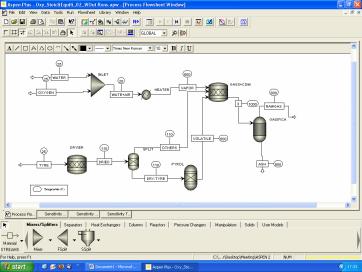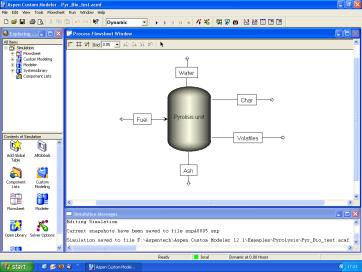655d Modeling and Simulation of Biomass Pyrolysis as a First Step in a Gasification-Based System
Narendar R. Mitta, Claudia J. Gómez, Enrique Velo and Luis Puigjaner*.
Department of Chemical Engineering, Universitat Politècnica de Catalunya (UPC).
Av. Diagonal, 647, ETSEIB, E-08028 Barcelona, Spain.
* Corresponding author. Tel: 34-93-4016678. Fax: 34-93-4010979. E-mail: luis.puigjaner@upc.edu Introduction
The need of the sustainable energy sources is growing as the fossil energy sources are diminishing. Moreover stringent environmental laws about the greenhouse gas emissions and boosting in oil prices are making the power generating companies to invest in the area of sustainable energy sources. Biomass refers to all the forms of plant-based material that can be converted into usable energy. Some other materials (such as tires, manufactured from either synthetic or natural rubbers) may be included under the general definition of biomass even though the material is not strictly biogenic (1). In Europe, Biomass is one of the sustainable energy sources that is attracting more interest in power production. This is due to the security level of energy supply in the future and less impact on the climate change.
Gasification-based systems and other thermochemical conversion processes represent an important option for the utilization of biomass and waste. It is an advanced power generation technology capable of co-producing a wide variety of commodity and premium products to meet future market requirements. The main steps in the conversion are pyrolysis, combustion and gasification. As the technology is scaled up to commercial size, a number of scientific and technical issues have to be resolved. There is an upsurge of interest in numerical models capable of simulating biomass pyrolysis as complementary to gasification, in order to integrate different operational conditions and varied feedstocks and help to achieve a better understanding of the reactions in the corresponding processes.
This paper will discuss modeling of biomass pyrolysis as a first step within a gasification-based system. Aspen Custom Modeler (ACM) is used as the simulation tool. ACM is a high-level process modeling language, specially suited to model complex phenomena and many different type of processes (2). Pyrolysis modeling
In the modeling of the pyrolysis unit, we considered two different approaches. For the first one, the drying process was assumed to occur in parallel with the devolatilization. It was assumed that the total yield of volatiles equals the volatile content of the parent fuel determined by the proximate analysis. The precision of this model depends on splitting parameters, which can be calculated from experimentation or taken from the literature (3).
For the second approach we considered a kinetic model based on several parallel devolatilization reactions (4, 5)
![]() (1)
(1)
where m is the sample mass normalized by the initial sample mass, M is the number of partial reactions and c is the fraction of the overall mass loss due to the j reaction. Each partial reaction is approximated by an Arrhenius type equation:
![]() (2)
(2)
Here A is the preexponential factor, E is the apparent activation energy, and n is the reaction order.
The two approaches are applied for the thermochemical treatment of waste tyres and some other biomass feedstocks. The pyrolysis custom model is then added to the gasification flow sheet, where a dynamic simulation run is made. The simulated results are compared with those reported in the literature and found to be in good agreement qualitatively in the range of operating conditions covered.

Figure 1: AspenPlus Flowsheet view of the Gasification process

Figure 2: ACM flowsheet view of the pyrolysis unit
Acknowledgement
Financial support received from the European Community projects (MRTN-CT-2004-512233, RFC-CR-04006, INCO-CT-2005-013359) and the Generalitat de Catalunya (FI grant with the European Social Fund ) is fully appreciated. References
(1) Klass, D.L. Biomass for renewable energy, fuels, and chemicals. Academic Press, San Diego, CA., (1998).
(2) www.aspentech.com
(3) Petersen, I. et al. Experimental Investigation and Modelling of Gasification of Sewage Sludge in the Circulating Fluidized Bed. Chemical Eng. and processing 44, (2004), 717
(4) Gómez, C. et al. Further Application of a Revisited Summative Model for Kinetics of Biomass Pyrolysis. Ind. Eng. Chem. Res. 43 (2004), 901.
(5) Gómez, C. et al. Slow Pyrolysis of Woody Residues and an Herbaceous Biomass Crop: A Kinetic Study. Ind. Eng. Chem. Res. 44 (2005), 6650.